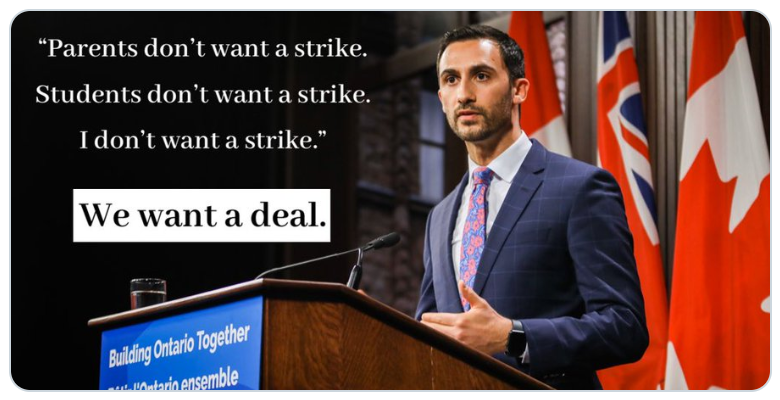It has taken a lot of restraint to ignore the volumes of micro-aggressive, passive aggressive, aggressive, and macro-aggressive comments flying around the Twitterverse about education since our most recent contract with the government expired this past August.
And then there is the elected official du jour with the education portfolio.
I have tried not to focus on the orchards of low hanging fruit being grown by our current Education Minister at the behest of his leader and his agenda. Elected or not, it is imperative of this incumbent and every other MPP to serve the public better. This means, any disinegenous attempts to villify our profession through weak one-liners and scripted media apperances as a scare tactic have to end. Saying you want a deal and then not bargaining will never be deemed as negotiating.
Despite not having a contract, all educators continue their tireless work on behalf of students to educate, encourage, and move forward even though our government managed to cut teachers and course offerings, and then wrote themselves a nearly 5 month absence note with a retro-active pay raise for good measure. This is not a sustainable situation. It is however, a recipe for a toxic and uncertain future.
What the province’s students need now is a government that sees, supports, and serves them and not the interests of corporate bullies or privateers bent on profiting from manufactured crises in public education. Instead they are blasted with a daily dose of misinformation without consideration of the present or the future. Our youth deserve a future and the truth.
This is what they are getting.

In between not negotiating, there have been absolutely zero authentic moments when this elected official sat at the table, conducted meaningful dialogue with teachers, or made an unscripted appearance at a public school without a camera crew. Maybe he should read my Undercover Boss post.
Instead it’s a steady stream of steamy slurry being served to the public via social media and scripted segments. #somethingsmells
Ontario education minister deletes tweet after social media backlash
“Lecce’s office told Global News on Thursday that the location of the photos was chosen due to timing and convenience, saying the decision was not made in an effort to avoid going to one of the province’s public schools but instead so as not to create a disruption.”
“My negotiating team stands ready for meaningful, good-faith bargaining 24/7, to reach the deals Ontario students and families deserve. There is a path to a deal, and it requires all parties to be reasonable and fair and put the needs of our children first.”
https://news.ontario.ca/edu/en/2019/11/statement-from-education-minister-on-osstf-strike.html
“Strikes hurt kids. Our Government has been clear, we want deals that keep students in class. For teacher unions to leave the table, to turn their back on our children, and to escalate to the point of compromising their education, is deeply troubling for parents and our Government.”
Cue Dr Carol Campbell from OISE and a litany of very committed educators who, to no surprise, have provided the corrections and descriptive feedback. Follow the thread all the way through. I especially like the part where the OntGov will never leave the table and be available 24/7. The OSSTF is also working hard at fact checking the M.O.Ed’s claims. #onceateacheralwaysateacher
There is nothing helpful about using the hashtag #strikeshurtkids that could ever be considered conscionable compared to the budget cuts being inflicted in our province. For so many people concerned about the public purse, a vision prescription update may be forthcoming to help them see the red ink that will stain the ledgers of future generations of Ontarians. When the people are denied adequate and equitable access to the world class education system that already exists in Ontario, the costs will make the current deficit look like an OLG winfall. The shortsightedness of this will end up costing us all. #antithetical #malfeasance or #unethical #incompetance
Think of overburdened social service systems, the disenfranchisement of students who have had their course options stolen, or of the marginalized/at-risk youth who deserve more interactions with opportunities and adults who are equipped to support them. Think about the danger to the economy of an underprepared/underserved workforce. This is why we need to keep up the struggle and fight against the visionless economic tyranny of the day. #cutshurtkids
Cuts Hurt Us All
Not to be overlooked, our collective rights as a union are being threatened by a pack of budget wolves that is blind to all but the bottom line. Few if any, have ever dared to step foot into the very institutions they wish to “save” and witness the magic and miracles being performed by teachers and support staff everyday without a press conference or a contract. Now that’s putting students first. #ETFOStrong

